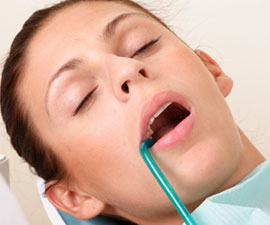What are the different types of sedation dentistry?
Many patients are nervous about the dentist, and even patients who are not are concerned that the appropriate pain management is used in the right way. Some patients also tend to be nervous about some kinds of sedation more than others, while other patients are more concerned with cost of the chosen process. Happily there are many effective kinds of dental sedation to choose from.
Sedation methods in dentistry are classified according to both method of administration – how the sedation is applied – and level or strength of sedation. The primary methods of administration are inhalation sedation, intravenous sedation, and general anaesthetic. The primary grades or strengths vary between practitioners somewhat, but the American Dental Association list them as local anaesthesia, minimal sedation, moderate sedation, deep sedation, and general anaesthesia.
Local Anaesthetic
Most of us are familiar with local anaesthetics. They are generally given using a topical wipe and a small local injection (intravenous sedation.) This is perhaps the most common anaesthetic for the removal of certain teeth and for filling work. This anaesthetic is sometimes used in conjunction with inhalation sedation or laughing gas.
Inhalation (Gas) and Oral Sedatives
Certain orally administered sedatives and inhalation sedation allows dentists to achieve what is called anxiolysis in patients: a drug induced state where the patient can respond to verbal commands and light touch. The level of sedation achieved this way can range from minimal to deep, as well as general anaesthesia.
Neither gas nor oral sedative method requires needles or other invasive equipment. With inhalation sedation, a gas is administered orally into the bloodstream via the lungs through a mask. The gas is usually Nitrous Oxide or laughing gas, or possibly Methoxyflurane. It is administered carefully in safe quantities to achieve the desired level of sedation – from minimal to deep or even general anaesthesia (full ‘unconsciousness’.)
During minimal sedation achieved with gas and or sedatives, the patient will be drowsy and mentally slow (absolutely no driving!) but able to speak, respond to touch and conversation, aware of their surroundings, and able to breathe without any assistance.
Moderate sedation is applied gradually to ensure exactly the right level of sedation. It means the patient will be less responsive, but still able to respond to verbal commands and light touch with gestures and pointing (or nodding and shaking the head) and some mumbling: the dentist will still be able to communicate with the patient.
Deep sedation is also applied gradually, and makes the patient very drowsy and leaves them only just responsive to load commands and heavy touch (a patient needs to be ‘roused’.) The patient may require assistance breathing or keeping their airway open.
Conscious Intravenous Sedation
This is usually a moderate to deep sedation, and the patient generally remembers nothing of the procedure. As indicated by the name of the procedure, this involves the use of a needle to place the anaesthetic in the bloodstream.
General Anaesthetic
This is usually achieved with intravenous drugs using needles, but can be achieved using sedatives and gas combined. Patients will be fully unconscious and unable to respond unless drugs are administered to remove the anaesthetic effects. The patient will probably require help keeping their airway open, and heart rates have to be monitored. This level of sedation is most costly, generally requires an anaesthetist, and is complex depending upon the manner in which it is administered.
Choosing Your Anaesthetic
The dentist and anaesthetist often have a lot of knowledge about what will work best for pain free dentistry given your weight, age and other more complex factors, and so their recommendations are very sound. When making a choice you should make sure to inform the clinician or dentist if you have ever had bad reactions to any kind of anaesthetic or sedation in the past, or have any special allergies or serious health complaints (especially heart, liver, and kidney problems.) Alcohol should not be consumed prior to any dental treatment involving sedation.
Joanne Lemke is a final year creative writing student at UOW, who is looking to break into the corporate copywriting space once she graduates and hopefully go on to eventually some day write a book around her other passions, namely beauty, cooking and travel.
